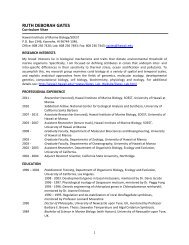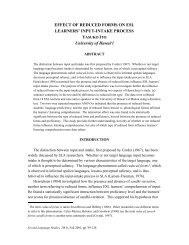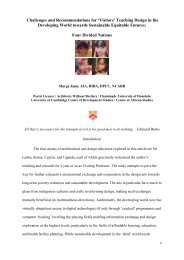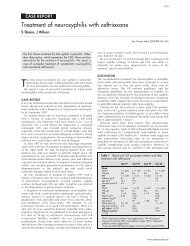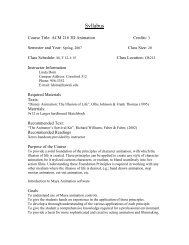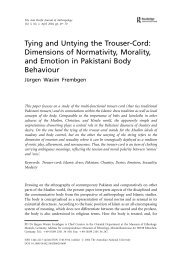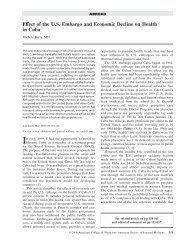Vasectomy Reversal (PDF)
Vasectomy Reversal (PDF)
Vasectomy Reversal (PDF)
Create successful ePaper yourself
Turn your PDF publications into a flip-book with our unique Google optimized e-Paper software.
A MERICAN S OCIETY FOR R EPRODUCTIVE M EDICINE<br />
PRACTICE COMMITTEE REPORT<br />
A Technical Bulletin<br />
VASECTOMY REVERSAL<br />
August 1999<br />
PATIENT EVALUATION<br />
Although reversal of vasectomy can be technically<br />
performed for most candidates, the appropriateness<br />
and ultimate success depends on both<br />
male and female fertility factors. The age and fertility status of<br />
the female partner should be included in the discussion of success<br />
rates. 1 General medical problems that would complicate<br />
any surgical procedure should be considered prior to vasectomy<br />
reversal. Patients who desire vasectomy reversal for reasons<br />
other than fertility (psychologic reasons or discomfort) should<br />
be advised to seek counseling or more conservative means of<br />
pain reduction prior to proceeding with vasectomy reversal.<br />
They also should be informed that neither epididymectomy nor<br />
reversal of the vasectomy necessarily will relieve their scrotal<br />
discomfort. Physical examination may reveal that a very long<br />
segment of the vas deferens was removed during the vasectomy,<br />
thus alerting the surgeon to the possible need for a nonstandard<br />
incisional approach. Examination also may reveal testicular<br />
abnormalities or epididymal induration, which indicates<br />
that vasoepididymostomy may be necessary when the reversal<br />
is performed.<br />
PREOPERATIVE TESTING<br />
No unique preoperative laboratory tests are required before a<br />
vasectomy reversal is performedother than the standard laboratory<br />
tests required by some facilities or anesthesiologists. About<br />
60% of men develop circulating antisperm antibodies after<br />
bilateral vasectomy. 2 Some investigators 3,4 suggest that such<br />
antibodies may decrease the chance for pregnancy after reversal,<br />
but the high overall postoperative conception rate (between<br />
50% to 70%), 5 and the questionable correlation of preoperative<br />
antibody testing with postoperative fecundability, makes preoperative<br />
antisperm antibody testing a controversial predictor of<br />
the patient’s postoperative fertility and is of unproven value. 6-13<br />
Before a patient undergoes a vasectomy reversal, his wife<br />
should be encouraged to have a gynecologic evaluation to<br />
assure adequate fertility potential, and the effect on fertility of<br />
female age should be explained. Counseling of the couple as to<br />
any foreseeable complications of pregnancy, such as fetal chromosomal<br />
abnormality if the wife is of an advanced age, is<br />
mandatory, as it is when presenting any procedure to promote<br />
progeny in the older female patient. The option of epididymal<br />
aspiration or testicular sperm aspiration combined with<br />
IVF/ICSI should be discussed in addition to a second attempt at<br />
vasectomy reversal, but current data suggest that this may not<br />
be cost effective. 14,15<br />
OPERATIVE CONSIDERATIONS<br />
Anesthesia<br />
<strong>Vasectomy</strong> reversal may be performed with local, regional, or<br />
A Technical Bulletin is a brief (6-8 page) presentation of a diagnostic or therapeutic procedure, with selected<br />
references from the literature.
2<br />
A MERICAN S OCIETY FOR R EPRODUCTIVE M EDICINE<br />
general anesthesia. The choice of anesthesia depends on the<br />
preference of the surgeon and patient. Local anesthesia may be<br />
administered by infiltration of the spermatic cord at the level of<br />
the pubic tubercle and/or by infiltration of perivasal tissue just<br />
above the vasectomy site.<br />
Placement of Incision<br />
A vasectomy reversal usually is performed through vertical<br />
incisions in the anterior aspect of each side of the scrotum. If<br />
the vasectomy was performed at a very high scrotal level, or if<br />
a long segment of the vas deferens was removed at the time of<br />
the vasectomy, it may be necessary to extend the scrotal incisions<br />
up into the lower inguinal region. An alternate approach<br />
in such situations is an infrapubic incision. 16 This incision provides<br />
ready access to the old vasectomy site when the vasectomy<br />
was performed at an unusually high level and which avoids<br />
anastomotic tension by allowing mobilization of an adequate<br />
length of the abdominal vas when there is a long distance<br />
between the vasal ends.<br />
General Intraoperative Considerations<br />
If vasovasostomy is to be performed, it may or may not be necessary<br />
to expose the testis and epididymis. When not required<br />
to isolate the ends of the vas, it is preferable to avoid exposure<br />
of the testis and epididymis, in order to prevent adhesions of the<br />
tunica vaginalis that could make later performance of a vasoepididymostomy,<br />
if needed, more difficult. The ends of the vas<br />
deferens above and below the old vasectomy site may be<br />
exposed through 2 to 3 cm vertical scrotal incisions. If vasoepididymostomy<br />
is required, then the surgeon must extrude the<br />
scrotal contents and incise the anterior parietal tunica vaginalis.<br />
As soon as the scarred ends of the vas have been excised,<br />
patency of the abdominal end of the vas is tested, and fluid from<br />
the testicular end is examined microscopically for the presence<br />
of sperm. Patency of the abdominal end may be assured by<br />
observing the free flow of sterile irrigant solution instilled<br />
through a 24-gauge blunt tip needle. Formal vasography rarely<br />
is necessary.<br />
When microscopic examination of the testicular vasal fluid<br />
is performed, the sperm quality in the vas fluid generally is categorized<br />
into one of five grades l,17 as follows:<br />
Grade 1 - mainly normal motile sperm<br />
Grade 2 - mainly normal nonmotile sperm<br />
Grade 3 - mainly sperm heads<br />
Grade 4 - only sperm heads<br />
Grade 5 - no sperm<br />
If the vas fluid has a thick, creamy consistency, it should<br />
be diluted with normal saline to allow observation of sperm that<br />
otherwise may be overlooked because they are packed together<br />
tightly and obscured by debris in the viscous fluid. The person<br />
who performs the microscopic examination of the intraoperative<br />
vas fluid must be alert to identify sperm heads that do not<br />
have attached tails.<br />
The surgeon should bypass the entire scarred portion of the<br />
vas above and below the vasectomy site to permit anastomosis<br />
of viable tissue. The ends of the vas are placed in an approximating<br />
clamp and are advanced toward each other to facilitate<br />
anastomotic suturing. Some surgeons prefer to perform the anastomotic<br />
suturing without using a vas approximator clamp and<br />
will often approximate peri-vasal tissue. The ends of the vas<br />
should be mobilized sufficiently to avoid anastomotic tension.<br />
Choice of Vasovasostomy or Vasoepididymostomy<br />
When grade one, two, three, or four sperm quality is present in<br />
the fluid that is obtained from the testicular end of the vas, vasovasostomy<br />
is performed. Even when only sperm heads (grade
T ECHNICAL B ULLETIN 3<br />
4) are present in the testicular vasal fluid, the results of vasovasostomy<br />
are good. 1 However, some experienced microsurgeons<br />
would perform vasoepididymostomy in this case. When sperm<br />
are not present in the intraoperative vas fluid, the surgeon must<br />
decide if vasovasostomy or vasoepididymostomy is more<br />
appropriate. If vasovasostomy is performed when sperm are not<br />
present in the intraoperative vas fluid, the chances of the return<br />
of sperm to the semen (patency) and of pregnancy are best<br />
when the vas fluid appears watery (clear, colorless, and transparent),<br />
but are lower when the fluid appears cloudy and are<br />
even worse when the fluid appears thick and creamy. 1<br />
When sperm are absent from the vas fluid and the fluid<br />
does not appear watery, the surgeon may be able to determine if<br />
vasovasostomy or vasoepididymostomy is more appropriate by<br />
inspecting the epididymis using optical magnification. When a<br />
discolored or indurated area is present in the epididymis, it<br />
usually indicates that a back pressure induced rupture of the<br />
epididymal tubule occurred after vasectomy, resulting in<br />
obstruction at the site of tubular rupture. The surgeon also may<br />
observe a level of demarcation in the epididymis above which<br />
the epididymal tubule appears dilated and below which it<br />
appears collapsed. In both these situations, vasoepididymostomy<br />
will be required. 18 The decision to perform vasovasostomy<br />
or vasoepididymostomy also may depend upon the time interval<br />
after vasectomy and upon the surgeon's experience with performing<br />
microsurgical vasoepididymostomy.<br />
Anastomotic Methods<br />
There is general agreement that results of vasovasostomy are<br />
better after microsurgical anastomoses than after macrosurgical<br />
anastomoses, although some surgeons still report favorable<br />
results using macrosurgical techniques. 5 The surgeon who uses<br />
the operating microscope and microsurgical techniques should<br />
have had formal microsurgical laboratory training.<br />
Most surgeons use monofilament nylon for anastomotic<br />
suturing. In order to prevent damage to the vas, only bipolar<br />
cautery or a small ophthalmic cautery unit should be used when<br />
it is necessary to cauterize bleeding vessels on the adventitia of<br />
the vas. These cautery units produce minimal areas of tissue<br />
damage compared to the area of damage created by monopolar<br />
cautery. Cautery should not be used on the opposing transected<br />
ends of the vas.<br />
Vasovasostomy by a modified one layer anastomosis 19<br />
may be performed by placing four to eight interrupted 9-0 nylon<br />
sutures through the full-thickness of each end of the vas. After<br />
these sutures are tied, interrupted 9-0 nylon sutures are placed<br />
through the outer muscular layer between the full-thickness<br />
sutures.<br />
Many surgeons prefer a two-layer microsurgical anastomosis<br />
17 when performing a vasovasostomy. Five to eight interrupted<br />
sutures of 10-0 nylon are used to connect the inner<br />
mucosal edges of the ends of the vas. These mucosal sutures<br />
should include a small portion of the inner muscular layer. After<br />
the mucosal sutures have been tied, seven to 10 outer muscular<br />
layer sutures of 9-0 nylon are placed and tied.<br />
The results of vasoepididymostomy are better with microsurgical<br />
anastomoses than with macrosurgical anastomoses.<br />
Since it is seldom possible to determine preoperatively if vasoepididymostomy<br />
will be required in a man undergoing vasectomy<br />
reversal, only surgeons skilled in both vasoepididymostomy<br />
and vasovasostomy should perform vasectomy reversal. 20,21<br />
Microsurgical vasoepididymostomy may be performed either<br />
using an end-to-end 20 or an end-to-side method 21 . In order to<br />
perform the end-to-end method, the epididymis is transected<br />
transversely at serial intervals of 0.5 to 1 cm., starting at the
4<br />
A MERICAN S OCIETY FOR R EPRODUCTIVE M EDICINE<br />
caudal end and progressing superiorly until a level is reached at<br />
which the epididymal tubular fluid contains sperm. The end-toside<br />
method is performed by incising through the epididymal<br />
tunic and then into a single isolated epididymal tubule, starting<br />
caudally and progressing superiorly, until a level is reached at<br />
which sperm are present in the epididymal tubular fluid. With<br />
either method, the vas mucosa is approximated to the opened<br />
edges of the epididymal tubule with four to six interrupted<br />
sutures of 10-0 nylon, and the outer muscular layer of the vas is<br />
approximated to the incised edges of the epididymal tunic with<br />
seven to 10 interrupted sutures of 9-0 nylon.<br />
It is important that the vasoepididymal anastomosis is performed<br />
at a level above the epididymal obstruction. This is<br />
assured by identifying intact sperm in the epididymal tubular<br />
fluid. However, the anastomosis also should be performed at<br />
the most caudal level at which sperm are present in the epididymal<br />
tubular fluid in order to maximize postoperative fertility<br />
rates.<br />
POSTOPERATIVE CARE<br />
The use of drains and of antibiotics is optional. The patient is<br />
advised to use a scrotal supporter and to avoid heavy physical<br />
activity for three to four weeks. He also is advised to avoid sexual<br />
intercourse for at least two weeks postoperatively.<br />
Postoperative pain generally is controlled with oral analgesics.<br />
COMPLICATIONS<br />
There are relatively few complications after vasectomy reversal<br />
procedures. Postoperative hematomas and deep infections are<br />
rare. Such complications may be managed with standard methods<br />
and rarely require surgical drainage.<br />
POSTOPERATIVE PATIENT MONITORING<br />
After either vasovasostomy or vasoepididymostomy, semen<br />
analyses are obtained every two to three months, either until<br />
sperm concentration and motility are normal or until a pregnancy<br />
occurs. If sperm concentration and motility become normal,<br />
then subsequent semen analyses are obtained at approximately<br />
four month intervals until a pregnancy occurs. Such<br />
monitoring of the semen assures that obstruction due to late<br />
anastomotic scar tissue formation, which occurs in 3% to 12%<br />
of patients after vasovasostomy 22,23 and 21% after vasoepididymostomy,<br />
23 has not occurred. If sperm are not present in the<br />
semen by six months after vasovasostomy, or by 18 months<br />
after vasoepididymostomy, then the reversal has failed. If the<br />
patient develops normal sperm concentrations postoperatively<br />
and his wife does not become pregnant despite gynecologic<br />
reassurance of her normal reproductive status, then measurement<br />
of antisperm antibodies on the surface of the sperm (direct<br />
immunobead testing 24 is preferred) may help when advising the<br />
couple as to their choices for future approachs to achieve fertility.<br />
Most pregnancies occur within 24 months. 1<br />
RESULTS<br />
After macrosurgical vasovasostomy, sperm appear in the semen<br />
of about 80% of men, and 20% to 40% of their wives become<br />
pregnant. 5 After microsurgical vasovasostomy, sperm appear in<br />
the semen of 85% to 90% of men, and 50% to 70% of their<br />
wives become pregnant. 5 The Vasovasostomy Study Group<br />
found that results were progressively less favorable after microsurgical<br />
vasectomy reversal as the obstructive interval (time<br />
from vasectomy until its reversal) lengthened. 1 That group<br />
reported rates of return of sperm to the semen and pregnancy,<br />
respectively, in 1,247 patients to be 97% and 76% if the
T ECHNICAL B ULLETIN 5<br />
obstructive interval was less than three years, 88% and 53% if<br />
three to eight years, 79% and 44% if nine to 14 years, and 71%<br />
and 30% if 15 years or longer.<br />
The Vasovasostomy Study Group 1 similarly reported less<br />
favorable results after bilateral vasovasostomy with progressively<br />
poorer qualities of sperm in the intraoperative vas fluid.<br />
Rates of return of sperm to the semen and pregnancy, respectively,<br />
were 94% and 63% when grade 1 sperm quality was present<br />
bilaterally in the intraoperative vas fluid, 91% and 54% for<br />
grade 2, 96% and 50% for grade 3, 75% and 44% for grade 4,<br />
and 60% and 31% for grade 5.<br />
of the old anastomosis. The vas fluid obtained through the vasotomy<br />
incision then is examined microscopically for the presence<br />
of sperm. Patency of the old anastomosis is tested, as previously<br />
described. If sperm are absent from the vas fluid<br />
obtained from the vasotomy site during a reoperative procedure,<br />
then vasoepididymostomy will be required. If the old<br />
anastomosis is obstructed, it is usually resected before the<br />
repeat anastomosis is performed. When performing reoperative<br />
vasovasostomy, the surgeon should bypass all of the scarred<br />
portion of the vas and mobilize a sufficient length of the<br />
abdominal end of the vas to avoid anastomotic tension.<br />
The Vasovasostomy Study Group 1<br />
confirmed Lee's<br />
Of 222 reoperative vasectomy reversals reported by the<br />
report 25 that the results of microsurgical modified one-layer and<br />
microsurgical two-layer anastomoses are comparable. After<br />
microsurgical end-to-side vasoepididymostomy performed for<br />
the purpose of vasectomy reversal, a recent large series reported<br />
that sperm appeared in the semen in 84% (36 of 48) of men<br />
followed six months or more, and 42% (17 of 41) followed 12<br />
months or longer achieved a pregnancy.<br />
MANAGEMENT OF OPERATIVE FAILURES<br />
Vasovasostomy Study Group, 1 75% had sperm in the semen<br />
postoperatively and 43% of the wives became pregnant.<br />
Although these results of reoperative vasectomy reversals are<br />
not as good as the results of first reversals, many patients<br />
believe that the percentage of conception is high enough for<br />
them to undergo a reoperation.<br />
INTRAOPERATIVE SPERM HARVESTING<br />
AND CRYOPRESERVATION<br />
Reoperation may be offered after a failed vasectomy reversal,<br />
although the majority of men who remain azoospermic after a<br />
reversal do not request another procedure. A repeat procedure<br />
after a failed vasovasostomy may be more difficult than the first<br />
reversal because a longer length of the vas will be involved with<br />
scarring than was involved at the time of the first procedure.<br />
Reoperation after a failed vasoepididymostomy may or may not<br />
be possible, depending on the amount of scar formation around<br />
the epididymis resulting from the first vasoepididymostomy.<br />
During reoperation after a failed vasovasostomy, the surgeon<br />
first should perform a microsurgical vasotomy below the level<br />
Before intracytoplasmic sperm injection (ICSI) was available,<br />
patients who inquired about intraoperative sperm harvesting<br />
and cryopreservation in case the vasectomy reversal failed were<br />
informed that the number and percentage of motility of sperm<br />
obtained intraoperatively both were too low for the thawed<br />
sperm to be useful later for insemination or in vitro fertilization<br />
(IVF). However, the availability of ICSI technology has<br />
encouraged some surgeons to offer cryopreservation of sperm<br />
that may be harvested during vasectomy reversals.<br />
Cryopreservation of sperm during vasoepididymostomy is<br />
especially important because of a reported 35% rate of
6<br />
A MERICAN S OCIETY FOR R EPRODUCTIVE M EDICINE<br />
azoospermia after microsurgical vasoepididymostomy. 23 Other<br />
investigators have reported that motile sperm were present in<br />
the intraoperative vasal and epididymal fluid in 35% of 603<br />
vasectomy reversals. 26<br />
However, performance of a vasal or epididymal anastomosis<br />
should be prioritized over sperm harvesting during vasectomy<br />
reversals. The surgeon should perform the reversal at the<br />
location farthest from the testicle where intact sperm, regardless<br />
of their motility, are present, rather than closer to the testicle in<br />
order to harvest motile sperm. Before sperm harvesting and cryopreservation<br />
are performed, the patient and his partner should<br />
assess the cost effectiveness of, and their ability to afford,<br />
IVF/ICSI. When harvesting sperm during vasectomy reversals,<br />
surgeons must alert laboratory personnel to cryopreserve small<br />
aliquots of sperm that are appropriate for later use with ICSI<br />
rather than larger aliquots for either vaginal or intrauterine<br />
insemination or IVF without ICSI. 27<br />
REFERENCES<br />
1. Belker AM, Thomas AJ Jr, Fuchs EF, Konnak JW, Sharlip<br />
ID. Results of 1,469 microsurgical vasectomy reversals by<br />
the Vasovasostomy Study Group. J Urol. 1991;145:505-<br />
511.<br />
2. Thomas AJ Jr, Pontes JE, Rose NR, Segal S, Pierce JM Jr.<br />
Microsurgical vasovasostomy: immunologic consequences<br />
and subsequent fertility. Fertil Steril. 1981;35:447-450.<br />
3. Linnet L, Hjort T. Fogh-Anderson P. Association between<br />
failure to impregnate after vasovasostomy and sperm<br />
agglutinins in semen. Lancet. 1981;1: 117-119.<br />
4. Linnet L. Clinical immunology of vasectomy and vasovasostomy.<br />
Urology. 1983;22:101-114.<br />
5. Belker AM. Microsurgical vasectomy reversal. In: Lytton<br />
B, Catalona WJ, Lipshultz LI, McGuire EJ, editors.<br />
Advances in Urology. Chicago: Year Book Medical<br />
Publishers, 1988:193-230.<br />
6. Meinertz H, Linnet L, Fogh-Andersen P, Hjort T. Antisperm<br />
antibodies and fertility after vasovasostomy: A follow-up<br />
study of 216 men. Fertil Steril. 1990;54(2):315-<br />
321.<br />
7. Vrijhof HJ, Dalaere KP. Vasovasostomy results in 66<br />
patients related to obstructed intervals and serum agglutinin<br />
titers. Urologia Internationalis. 1994;53(c):143-146.<br />
8. Fuchs EF, Alexander NJ: Immunologic considerations<br />
before and after vasovasostomy. Fertil Steril. 1983;40(4):<br />
497-499.<br />
9. Parslow JM, Royle MG, Kingscott MM, Wallace DM,<br />
Hendry WF. The effects of sperm antibodies on fertility<br />
after vasectomy reversal. Am J Reprod Immunol. 1983;<br />
3(1): 28-31.<br />
10. Collins JA, Burrows EA, Yeo J. YoungLai EV. Frequency<br />
and predictive value of antisperm antibodies among infertile<br />
couples. Hum Reprod. 1993;8:592-598.<br />
11. EggertKruse W, Christmann M, Gerhard I, Pohl S, Klinga<br />
K, Runnebaum B. Circulating antisperm antibodies and<br />
fertility prognosis: a prospective study. Hum Reprod. 1989;<br />
4:513-520.<br />
12. Witkin S, David S. Effect of sperm antibodies on pregnancy<br />
outcome in a subfertile population. Am J Obstet<br />
Gynecol. 1988;158:59-62.<br />
13. Menge AC, Medley NE, Mangione CM, Dietrich JW. The<br />
incidence and influence of antisperm antibodies in infertile<br />
human couples on sperm-cervical mucus interactions and<br />
subsequent fertility. Fertil Steril. 1982;38:439-446.<br />
14. Pavlovich CP, Schlegel PN. Fertility options after vasectomy: Acost<br />
effectiveness analysis. Fertil Steril. 1997;67:133-141.
T ECHNICAL B ULLETIN 7<br />
15. Kolettis PN, Thomas AJ Jr. Vasoepididymostomy (VE)<br />
for vasectomy reversal: a critical assessment in the era of<br />
ICSI. J Urol. 1996;155:443A.<br />
16. Belker AM. Infrapubic incision for specific vasectomy<br />
reversal situations. Urology. 1988;32:413-415.<br />
17. Silber SJ. Microscopic vasectomy reversal. Fertil Steril.<br />
1977;28:1191-1202.<br />
18. Silber SJ. Epididymal extravasation following vasectomy<br />
as a cause for failure of vasectomy reversal. Fertil Steril.<br />
1979;31:309-315.<br />
19. Schmidt SS. Vas anastomosis: a return to simplicity. Br J<br />
Urol. 1975;47:309-314.<br />
20. Silber SJ. Microscopic vasoepididymostomy: specific<br />
microanastomosis to the epididymal tubule. Fertil Steril.<br />
1978;30:565-571.<br />
21. Thomas AJ Jr. Vasoepididymostomy. Urol Clin North Am.<br />
1987;14:527-538.<br />
22. Belker AM, Fuchs EF, Konnak JW, Sharlip ID, Thomas<br />
AJ Jr. Transient fertility after vasovasostomy in 892<br />
patients. J Urol. 1985;134:75-76.<br />
23. Matthews GJ, Schlegel PN, Goldstein M. Patency following<br />
microsurgical vasoepididymostomy and vasovasostomy:<br />
temporal considerations. J Urol. 1995;154:2070-2073.<br />
24. Bronson R, Cooper G, Rosenfeld D. Sperm antibodies:<br />
their role in infertility. Fertil Steril. 1984;42:171-183.<br />
25. Lee HY. A 20-year experience with vasovasostomy. J Urol.<br />
1986;136:413-415.<br />
26. Belker AM, Bergamini D. The feasibility of cryopreservation<br />
of sperm harvested intraoperatively during<br />
vasectomy reversals. J Urol. 1997;157(4):1292-1294.<br />
27. Hoekstra T, Witt M. The success, yield and outcome of<br />
microscopic aspiration at the time of vasal reconstruction.<br />
J Urol. 1996;155:364A.
8<br />
T ECHNICAL<br />
B ULLETIN<br />
This report was developed under the direction of the Practice<br />
Committee of the American Society for Reproductive Medicine<br />
as a service to its members and other practicing clinicians.<br />
While this document reflects appropriate management of a<br />
problem encountered in the practice of reproductive medicine,<br />
it is not intended to be the only approved standard of practice<br />
or to dictate an exclusive course of treatment. Other plans of<br />
management may be appropriate, taking into account the needs<br />
of the individual patient, available resources, and institutional<br />
or clinical practice limitations. The committee wishes to thank<br />
Arnold M. Belker, M.D., for his assistance in preparing this<br />
Technical Bulletin.<br />
COPYRIGHT 1999 AMERICAN SOCIETY FOR REPRODUCTIVE MEDICINE<br />
1209 Montgomery Highway, Birmingham, Alabama 35216-2809 • phone 205/978-5000 • fax 205/978-5005<br />
e-mail asrm@asrm.org • URL http://www.asrm.org



